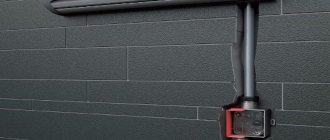But this is difficult work and a major investment, which can be 5-8 times or more difficult for the budget. Therefore, we will not consider these systems today, because there is a standard and affordable option - a split system for a house or apartment, or any separate room!
Choosing a place to install the air conditioner
There are situations when the installation of an air conditioner needs to be done after completing a fresh renovation. There is no desire to cut walls for mains and cables for supplying electrical energy, as well as to disturb the composition of the design. And then the customer decides to carry out external installation of communications... and this is ducts, corrugations or additional masking of pipes and cables using available methods. This option does not always look organic, although, depending on the interior, the solution may be a good one.
But it’s still better to think about installing the indoor air conditioner unit in advance, and hide communications in the walls, in niches, under the finishing and cladding of the walls. At the same time, you should act based on your own comfort, and not under the dictation of circumstances. And there are a lot of solutions on how to get a good result!
Above the cabinet
Sometimes in bedrooms you have to install the system above the furniture. This is very inconvenient, but if there are no options, the air conditioner should be mounted above the chest of drawers, and not above a tall cabinet.
And be sure to observe the following parameters: the distance between the surface of the furniture and the block should be about one hundred centimeters, with a distance between the split and the ceiling of at least ten centimeters.
Comfortable placement of the air conditioner
An option that is more promising in terms of using a cooling and heating system for the internal space. Here it is worth considering the power of the system, the area and total volume of the room, the direction of air flow, the installation height of the indoor unit!
It is very important that you feel the temperature change, but do not directly expose yourself to the air. Also, correct placement is distinguished by the exclusion of air flows into the head and back. This installation option can lead not only to colds, but also to more complex problems, including pneumonia, sore throat, and a host of ENT diseases. Therefore, you should avoid placement in which cold air will blow into your face, the back of your head or back, or other parts of the body!
The best options are a directed flow at a distance of one meter to the right or left, behind and on top of a person, as well as installing an air conditioner on the side walls, above the doorway in the room!
You should feel the change in air temperature in the room, and not its direct flow on you. Air conditioning is for comfort, not to spoil your health and well-being!
All details
Based on the calculation, certain data and wishes, the company develops an individual offer. Of course, without offering all the services: without painting or electrical work that may be necessary. Only then can you place an order for a new air conditioning system.
To sleep well, so that the body can recover properly at night, a good climate in the bedroom is necessary. Air conditioners are the best solution to combat changing weather conditions and help the user create an optimal climate for sleeping at night.
Installing an air conditioner near a window
This method is rational in terms of reducing costs, as well as the amount of work. And often the customer is not against the option, because the outer boxes that cover the air conditioner routes do not look the best... so their visual part is minimized. In addition, every meter of the route is an additional expense, which combines the gating of walls, the cost of copper pipes, the length of the laying, and further finishing. Savings take their toll, and the indoor unit is installed near the window, which is impractical in most cases:
The first inconvenience is the possibility of limiting the zone of temperature change in large rooms - the air conditioner can work pointwise, cooling or warming the space only around itself; The second is based on design interference. Situational decisions often have a negative impact on the design of residential premises, and an air conditioner near a window, installed unplanned and hastily, can become a visible spot that distracts attention; The third inconvenience is directly related to placement and operation. Installation of the indoor unit requires space, and is also installed, on average, 100-300 mm from the nearest obstacles on top and on the sides to allow the laying of communication routes, as well as the correct intake and release of air. Here we can also consider a ban on restricting air flow, which is affected by curtains and tulle; Additionally, it is worth paying attention to standard restrictions in the installation of the indoor unit, and this is placement above heating devices and radiators, which can negatively affect the proper operation of the air conditioner temperature sensors. In this case, the heating equipment is installed just under the windows or near them!
Such placement makes sense in small rooms, in the kitchen, in the office, where you will cool not only the nearest corner, but the entire room, even with low-power equipment. If this is an air conditioner for a spacious bedroom and living room, you need to make different decisions. There are two options: think about installation in the right place in advance, or after the repair, decorate the indoor unit, electrical cable, as well as the main lines of the air conditioner. Regardless of decisions, the guideline, I repeat, is strictly for your own comfort. Fortunately, there are many decorative possibilities today. And these are not only plastic boxes, but also wooden trim, masking communications with decorative rope or carved frames, as well as laying them in the thickness of the suspended ceiling...
Floor units
Like any other technology, they have both advantages and disadvantages.
The obvious advantages include:
- Small dimensions;
- Mobility - if necessary, they can be easily moved to any place in the room;
- No need for special installation.
They are ideal for small spaces.
The disadvantages include an increased noise level (this is definitely not the quietest air conditioner for a bedroom), as well as the fact that the compressor heats up during operation, and accordingly the performance drops somewhat. And if the design does not have a container for collecting condensate, then you will have to provide it yourself.
There is another type of splits - columnar ones, but they are installed in large rooms; they are practically not in demand in everyday life.
Based on the above, we can conclude: the most convenient option for maintaining a comfortable temperature in the bedroom would be to install a wall-mounted air conditioner.
Besides running quietly and filtering air, it does not consume much electricity (especially inverter split systems). In addition, there are many options for the design of the indoor unit, so it is easier to fit them into the interior of the room.
Where to install air conditioning in the bedroom
There are several options for rooms of different sizes:
- Installation above the head of the bed for a room of any size;
- Installing the air conditioner on the wall in front of the bed in the case of a large room, at a distance of at least 2.0-3.0 m from the bed;
- Placing an air conditioner in a large bedroom in almost any convenient place so that the air flow does not fall directly on resting people;
- Installation in a small room parallel to the bed, on the right or left, 0.8-1.0 m from the bed itself!
In any case, adjusting the blinds on the air conditioner unit is important. Their correct installation affects the air flow, and you can independently direct it higher or lower. This is convenient when installing the air conditioner above the headboard, when the blinds are installed parallel to the floor or with a minimal reverse slope to the unit. Then the flow of cold air falls a little further than your feet, behind the bed, gradually cooling the air near the sleeping place and without directly affecting the person, which can be harmful and dangerous!
The photo below shows an incorrect installation of the air conditioner, where, regardless of the adjustment of the blinds on the internal unit of the system, cold air will fall directly on vacationers... and, most dangerously, on the head and upper torso. If you cool the room in advance, turning off the air conditioner before resting, the option is acceptable. If you like to sleep with the room cooling on, it's better to install your air conditioner differently!
A more correct option for placing an air conditioner in the bedroom, which will make it possible to create a comfortable microclimate with no health risks, is to install the indoor unit above the headboard. A stream of cool air will fall next to the bed, without direct contact with the person. And this means minimizing danger and increasing sleep comfort!
Tip #4: Cool before bed
If you can't bear the cold wind while sleeping, you can still enjoy a cool bedroom. It's best to turn on the air conditioner about an hour before bed. The room can then cool down and the air conditioning can be turned off before bed.
Additionally, you can also use the timer feature. Set the air conditioner so that it turns off after a maximum of one hour. Because cool air especially helps when falling asleep. Once you fall asleep, your body temperature drops slightly on its own.
Placing an air conditioner in the living room
In this room, standard rules apply, which refer to the installation of the indoor unit in such a way that the flow of air at a given temperature does not fall directly on a person, but has the ability to change the microclimate around him, gradually regulating the temperature in the entire room.
Consider not only the main furniture for relaxation in the living room - sofas and armchairs, soft poufs and bean bags, but also your own zoning solutions. If the living room is combined with a dining area, sleeping or working place, the installation of an air conditioner should take these points into account.
One option is to install the indoor unit directed towards the least used area of upholstered furniture, at a short distance to reduce temperature concentration.
The second option is to place the air conditioner in the living room so that the flow of cold air is directed parallel to the seating areas, and also at some distance from the sofas and armchairs. Please note how the installation is done in the following photo:
What should the system be able to do?
Currently, manufacturers provide consumers with a large selection of air conditioners, but not all of them may be suitable for the bedroom.
To make your choice, you need to decide what the system should be able to do:
- Have a temperature control system with the smallest error (and adjustable using a remote control);
- Have an addition: a filter to clean the air from odors, dust, mites;
- Allows you to control the strength and direction of the air flow;
- Have a minimum noise level so as not to disturb sleep;
In addition, this household item should take up a small amount of space, be easy to operate, and have an additional heating option (for the cool season).
Air conditioning in the nursery
Many parents do not install air conditioning in their children's rooms due to the increased risk of negative effects on their health. In addition to the problem of incorrect placement and improper flow of cold air, there is a risk of children turning on the air conditioner on their own and playing under it outside the attention of parents. Therefore the decision is justified.
But if the children are adults, and one of the risks is reduced to zero, we only have the question of choosing the right place to install the indoor unit of the split system!
- Above a crib or a play area with blinds that are strictly horizontally oriented, not directed downward to allow cold air to flow into the area where children are present;
- Installation above the child’s workplace, desk and table with the same position of the blinds, when the air flow falls behind the child one to one and a half meters;
- Installing an air conditioner above the door, opposite a wall with a closet or shelves, where the child does not study, does not sleep, or plays on the floor!
Independently regulate the temperature and operating mode of the air conditioner in the nursery, avoiding sudden temperature changes!
Wall options
A quiet air conditioner for a bedroom with a low noise level, no higher than 25 decibels - this is a set with separate units. The noise is mainly from the outdoor unit, while the indoor unit operates almost silently.
A great addition is the “Sleep” function. In this mode, the air conditioner itself regulates the temperature, automatically lowering or raising it, creating the most comfortable conditions for relaxation.
All air conditioners are equipped with an air purification filter, and some models are also equipped with a HEPA filter designed to get rid of dust mites. There are devices that allow you to control the level of humidity in a room.
Air conditioning in the interior: where and how to hide the indoor unit
One of the most popular problems! Indeed, the indoor unit of a split system does not always fit organically into the design. Therefore, it is worth considering various solutions that will help combine it with the finished interior. But there is also a limitation, because in pursuit of a stylish atmosphere in the room, many forget that covering the air conditioner with curtains or solid boxes is strictly prohibited. This reduces the performance and resource of the system, leads to the concentration of temperatures in only one part of the room, as well as to the formation of condensation... and this means dampness, bacteria, and mold in the corners. The air flow cannot be blocked, but you can work with various visual camouflage techniques, which I will describe:
- Hide the air conditioner among wall-mounted furniture. These can be either individual shelves or sectional racks, as well as special consoles made taking into account the interior and directly for the installed indoor air conditioner unit;
- Install the air conditioner above the window so that it is possible to blur its outline with a bright light flux. Minimal attention should be paid to the frame of the window if there is a lot of sunlight from it;
- Integrate air conditioning into the interior. Modern styles feature a lot of plastic, glass and LED-lit elements, decor and accents. An air conditioner can be one of these;
- Buy an indoor unit in a color that matches the interior to blend it more organically into the overall design picture. But this technique is limited to the choice of color conditioners, so the solution may be to paint the block or cover it with a special film, perhaps even with photo printing;
- Choose an unusual model. Internal blocks are not only rectangular in a horizontal direction, but also round, square, and with a duplicated shape. Although expensive, it is still an option that will help improve the appearance by placing it among pieces of furniture, decor, or even on its own on the wall;
- Place the air conditioner in a wall niche or ceiling box, thus minimizing its visual significance in the interior as much as possible;
- install a box on the indoor unit of the split system. It can be a plastic box, a carved wooden form, or a combination. Additionally, I would like to draw your attention to the fact that only the base can be covered, but not the air intake and supply areas;
- Integrate into the color scheme. Abstract drawings of different colors on the wall, bright paintings as accents, as well as multi-colored furniture, one of the colors of which matches the color of the air conditioner - an additional option for compatibility of the air conditioner with the design!
© design-guru.moscow
© www.pinterest.com
Having studied these ideas, the air conditioner can be installed not only correctly, but also without disturbing the interior. You should not make rash and hasty decisions that can harm the design of the premises and your health. Follow these options, and you will definitely be able to efficiently and organically integrate the indoor unit of the air conditioning system into the interior of the living room, kitchen, bedroom or children's room!
Above the bed
The natural desire to place the block above the bed is not always correct. Such a decision can only be determined by the fact that there is simply no other place.
If you still had to hang the block directly above the bed, you should provide some kind of screens designed to disperse air flows.










